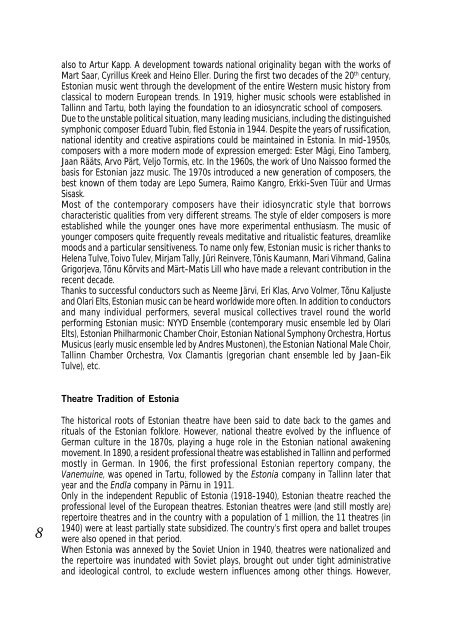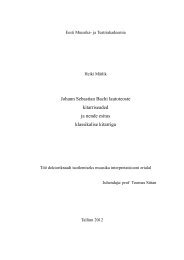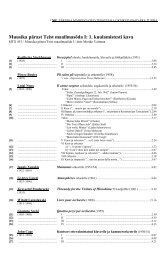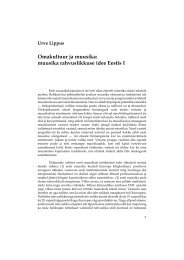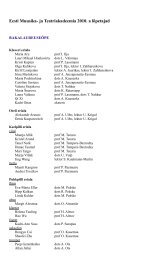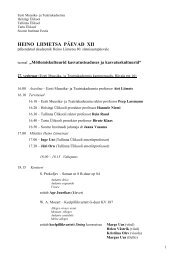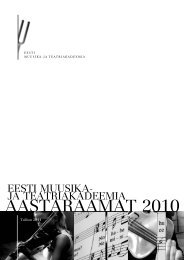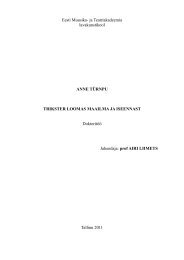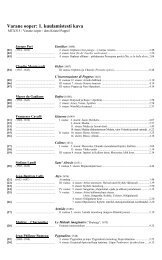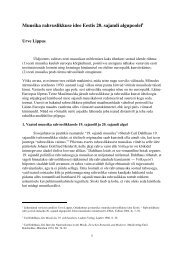You also want an ePaper? Increase the reach of your titles
YUMPU automatically turns print PDFs into web optimized ePapers that Google loves.
also to Artur Kapp. A development towards national originality began with the works of<br />
Mart Saar, Cyrillus Kreek and Heino Eller. During the first two decades of the 20 th century,<br />
Estonian music went through the development of the entire Western music history from<br />
classical to modern European trends. In 1919, higher music schools were established in<br />
Tallinn and Tartu, both laying the foundation to an idiosyncratic school of composers.<br />
Due to the unstable political situation, many leading musicians, including the distinguished<br />
symphonic composer Eduard Tubin, fled Estonia in 1944. Despite the years of russification,<br />
national identity and creative aspirations could be maintained in Estonia. In mid-1950s,<br />
composers with a more modern mode of expression emerged: Ester Mägi, Eino Tamberg,<br />
Jaan Rääts, Arvo Pärt, Veljo Tormis, etc. In the 1960s, the work of Uno Naissoo formed the<br />
basis for Estonian jazz music. The 1970s introduced a new generation of composers, the<br />
best known of them today are Lepo Sumera, Raimo Kangro, Erkki-Sven Tüür and Urmas<br />
Sisask.<br />
Most of the contemporary composers have their idiosyncratic style that borrows<br />
characteristic qualities from very different streams. The style of elder composers is more<br />
established while the younger ones have more experimental enthusiasm. The music of<br />
younger composers quite frequently reveals meditative and ritualistic features, dreamlike<br />
moods and a particular sensitiveness. To name only few, Estonian music is richer thanks to<br />
Helena Tulve, Toivo Tulev, Mirjam Tally, Jüri Reinvere, Tõnis Kaumann, Mari Vihmand, Galina<br />
Grigorjeva, Tõnu Kõrvits and Märt-Matis Lill who have made a relevant contribution in the<br />
recent decade.<br />
Thanks to successful conductors such as Neeme Järvi, Eri Klas, Arvo Volmer, Tõnu Kaljuste<br />
and Olari Elts, Estonian music can be heard worldwide more often. In addition to conductors<br />
and many individual performers, several musical collectives travel round the world<br />
performing Estonian music: NYYD Ensemble (contemporary music ensemble led by Olari<br />
Elts), Estonian Philharmonic Chamber Choir, Estonian National Symphony Orchestra, Hortus<br />
Musicus (early music ensemble led by Andres Mustonen), the Estonian National Male Choir,<br />
Tallinn Chamber Orchestra, Vox Clamantis (gregorian chant ensemble led by Jaan-Eik<br />
Tulve), etc.<br />
Theatre Tradition of Estonia<br />
8<br />
The historical roots of Estonian theatre have been said to date back to the games and<br />
rituals of the Estonian folklore. However, national theatre evolved by the influence of<br />
German culture in the 1870s, playing a huge role in the Estonian national awakening<br />
movement. In 1890, a resident professional theatre was established in Tallinn and performed<br />
mostly in German. In 1906, the first professional Estonian repertory company, the<br />
Vanemuine, was opened in Tartu, followed by the Estonia company in Tallinn later that<br />
year and the Endla company in Pärnu in 1911.<br />
Only in the independent Republic of Estonia (1918-1940), Estonian theatre reached the<br />
professional level of the European theatres. Estonian theatres were (and still mostly are)<br />
repertoire theatres and in the country with a population of 1 million, the 11 theatres (in<br />
1940) were at least partially state subsidized. The country’s first opera and ballet troupes<br />
were also opened in that period.<br />
When Estonia was annexed by the Soviet Union in 1940, theatres were nationalized and<br />
the repertoire was inundated with Soviet plays, brought out under tight administrative<br />
and ideological control, to exclude western influences among other things. However,


